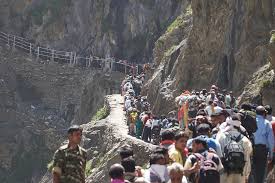What’s Pissu Top, the most gruelling segment of the Amarnath Yatra, like?

The Amarnath Yatra, one of India’s most revered pilgrimages, is a test of faith, endurance, and spiritual devotion. Nestled in the breathtaking Himalayas of Jammu and Kashmir, the journey to the sacred Amarnath Cave is both physically challenging and emotionally uplifting. Among the various segments of this high-altitude trek, Pissu Top stands out as the most daunting, often leaving pilgrims gasping for breath and digging deep into their inner reserves of strength. But what makes Pissu Top so notorious, and why is it remembered long after the yatra is over?
Where is Pissu Top Located?
Pissu Top is situated on the traditional Pahalgam route of the Amarnath Yatra. After crossing Chandanwari, the official starting point of the yatra, and walking for about 3–4 kilometers, pilgrims reach this steep and relentless climb. Perched at an altitude of around 11,000 feet, Pissu Top is the first real elevation gain, marking the beginning of the high-altitude terrain that lies ahead.
Why is Pissu Top So Challenging?
1. Unforgiving Steepness
The trail from Chandanwari to Pissu Top is infamous for its abrupt and steep ascent. The climb is short in distance but punishing in gradient. For many first-time pilgrims, it comes as an early shock—especially since the body has not yet had time to acclimate to the altitude. Even seasoned trekkers often find this part taxing due to its unrelenting slope.
2. Thin Air and Oxygen Drop
At elevations above 10,000 feet, the oxygen levels start to dip. Combined with the physical exertion of the climb, many yatris experience symptoms like shortness of breath, dizziness, or mild altitude sickness. Without adequate acclimatization, the steep climb to Pissu Top becomes all the more difficult.
3. Narrow, Crowded Paths
During peak yatra days, thousands of pilgrims, ponies, porters, and palanquins try to ascend the same narrow path. The congestion not only slows down the movement but also adds to the fatigue. In some sections, the trail is barely wide enough for two people to walk side by side.
4. Weather Hazards
The weather in the region is unpredictable. Rain, snowmelt, or fog can turn the trail slippery and treacherous. Even in July and August, temperatures can plummet, and sudden rainfall is not uncommon. These conditions make the steep terrain more dangerous, especially for those unprepared for such high-altitude treks.
The Legend Behind Pissu Top
Pissu Top is not just physically challenging—it holds mythological significance as well. According to legend, when Lord Shiva announced his intention to reveal the secrets of immortality (Amar Katha) at the Amarnath Cave, gods and demons alike wished to be the first to hear it. A battle ensued, and the gods emerged victorious. The defeated demons were piled into a massive heap, which is said to have formed Pissu Top. This symbolic backstory turns the climb into a spiritual test of will and determination.
Pilgrim Experiences: A Spiritual Test
Ask any pilgrim who’s completed the Amarnath Yatra, and most will recall Pissu Top as one of the toughest parts of the journey. Yet, they also describe it as a moment of transformation. The exhaustion felt during the climb is often countered by chants of “Bam Bam Bhole” echoing through the mountains, motivating yatris to keep moving.
For many, reaching the top feels like a mini-victory—a moment that instills confidence for the rest of the journey. The panoramic views of the Himalayan ranges, the cool breeze, and the shared camaraderie among pilgrims create a deep sense of spiritual fulfillment.
Tips for Tackling Pissu Top
If you’re planning to undertake the Amarnath Yatra, here are a few tips to help you conquer Pissu Top safely and efficiently:
✅ Prepare Physically in Advance
Begin cardiovascular training and stair climbing at least a month before the yatra. A strong set of lungs and legs will make the steep climb more manageable.
✅ Start Early
Try to begin your trek from Chandanwari early in the morning to avoid both the crowds and midday heat.
✅ Stay Hydrated and Eat Light
Drink plenty of water but avoid overfilling your stomach. Eating a light snack before the climb can give you the energy needed for the steep ascent.
✅ Use a Walking Stick
A trekking pole or stick can provide much-needed support and stability on slippery slopes.
✅ Hire a Pony or Porter if Needed
If you’re not confident about your fitness level, don’t hesitate to hire a pony or palanquin for this segment. Safety is always more important than pride.
Beyond Pissu Top: The Journey Continues
While Pissu Top may be the first major hurdle, it’s not the last. The journey ahead includes several more challenging sections such as Sheshnag, Mahagunas Top, and Panchtarni, before finally reaching the sacred Amarnath Cave. But once you’ve made it past Pissu Top, the boost in morale can carry you forward with renewed energy.
Final Thoughts: A Test of Faith and Fortitude
Pissu Top is more than just a steep climb—it’s a rite of passage for Amarnath yatris. It teaches resilience, patience, and the power of collective spirit. Whether you’re walking alone or surrounded by fellow devotees, every step toward the top becomes a prayer in motion.
By the time you reach the summit, the fatigue is overshadowed by a deep sense of spiritual connection. And when you look back from the top, watching the winding trail you just climbed, there’s an unmistakable sense of accomplishment and divine grace.
So, if you’re gearing up for the Amarnath Yatra, know this: Pissu Top will test you, but it will also prepare you—physically and spiritually—for the sacred path that lies ahead.






